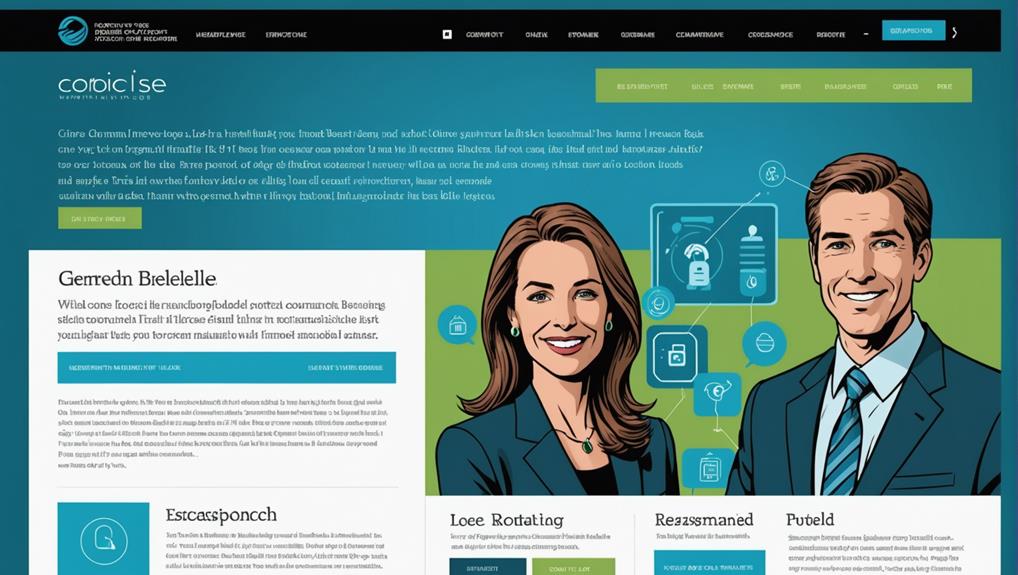
To build authority and trust through your website as a financial advisor, focus on clean, modern design that impresses visitors immediately. Use clear navigation to make it easy for clients to find what they need. High-quality images and consistent branding reflect your professionalism. Highlight your qualifications and include team bios to connect on a personal level. Testimonials serve as powerful proof of your success. Regularly update your content to keep it fresh and engaging, adapting to trends in finance. This thoughtful approach can enhance your credibility, making clients feel confident in your services. There's so much more to explore!
Key Takeaways
- Utilize clean, modern design to project professionalism and establish a trustworthy first impression for visitors.
- Incorporate clear navigation to enhance user experience and facilitate easy access to important information.
- Showcase client testimonials and case studies to provide social proof and illustrate successful outcomes.
- Display qualifications and team bios to enhance perceived expertise and foster personal connections with clients.
- Regularly update content and monitor analytics to ensure ongoing relevance and adapt to emerging financial trends.
Building Trust Through Design

Building Trust Through Design
When it comes to your website, design plays an essential role in building trust with potential clients. A clean and modern website design instantly conveys professionalism, much like the comprehensive web design services offered by iindigo Stockport. When visitors land on your site, their first impression matters a lot. You want them to feel confident in your services as a financial advisor. Using a visual hierarchy helps capture attention. Larger text and high-quality images make it easier for visitors to scan your content, reinforcing their trust.
Incorporating trust indicators, like client testimonials or industry awards, prominently on your landing pages boosts your credibility. When people see these elements, they feel more comfortable engaging with you. Consistency in branding also matters; it creates a positive user experience. High-quality images help foster emotional connections, making visitors more likely to return.
Additionally, offering engaging content, like blogs or resources, shows your ongoing expertise. Regular updates demonstrate you're responsive to client needs, enhancing their trust in you. By focusing on these aspects of website design, you can create a space that not only attracts visitors but also encourages them to reach out for your financial services
Essential Design Elements
Essential design elements play a pivotal role in creating an effective website for financial advisors. A polished and modern layout is vital for attracting visitors and establishing professionalism. First impressions matter, and a well-designed site can greatly impact user trust and engagement. To enhance your website design, consider these key elements:
- Clear navigation that makes finding information a breeze
- High-quality images that reflect your branding and values
- Responsive design for a seamless experience on all devices
- Prominent testimonials that serve as social proof of your credibility
When potential clients visit your site, they should easily navigate through your services and credentials. This straightforward navigation boosts user experience. Consistent branding and high-quality visuals not only elevate your site's appeal but also reinforce your firm's credibility. Including testimonials and case studies prominently helps establish trust, showcasing your capabilities and client successes.
Showcasing Expertise and Authority

Showcasing expertise and authority on your website is essential for attracting and retaining clients in the competitive financial advisory industry. When potential clients visit your site, they want to feel confident in your professional capabilities. Displaying your qualifications and certifications prominently can greatly enhance their perception of your expertise and authority.
Including team bios that highlight relevant experience and credentials builds a personal connection with visitors, which is vital for gaining trust and credibility. You can also use blog posts to share insights, tips, and industry updates. This not only showcases your knowledge but also addresses client needs and concerns.
Don't forget to showcase awards and recognitions, as these provide third-party validation of your success in the industry. Incorporating client testimonials and case studies is another powerful way to illustrate your problem-solving skills and successful financial outcomes. By doing this, you demonstrate your authority in guiding clients toward their financial goals.
In the end, all these elements work together to create a trustworthy website, making potential clients feel secure in their decision to choose you as their financial advisor.
Engaging Content Strategies
Engaging content strategies are key to capturing and retaining the attention of potential clients on your financial advisory website. By regularly updating your site with valuable information like blogs, podcasts, and articles, you can showcase your financial advisor's expertise. Here are some strategies to contemplate:
- Use client testimonials to highlight past successes and build trust with potential clients.
- Incorporate case studies that illustrate real financial scenarios, demonstrating your problem-solving capabilities.
- Focus on goal-oriented messaging to show a clear understanding of common client objectives.
- Keep your writing clear and straightforward, using industry-specific jargon only when necessary.
These tactics not only enhance visitor engagement but also reinforce your credibility as a financial advisor. When potential clients see how you help others achieve their financial goals, they're more likely to feel confident in your ability to guide them through thorough financial planning. Remember, your website is a reflection of your professionalism and commitment to helping clients. By using engaging content strategies, you can create a welcoming space that makes visitors feel understood and supported on their journey to financial success.
Continuous Improvement and Adaptation

Your financial advisory website isn't a static entity; it needs to evolve continuously to stay relevant and effective. Regular updates are vital, helping you reflect current market conditions and guaranteeing your visitors receive the most relevant information. This is where continuous improvement comes into play.
Monitoring website analytics and user feedback is imperative. By understanding what clients like and what they don't, you can enhance your website design. This adaptation makes it easier to stay competitive in a crowded marketplace, boosting visitor engagement.
Embracing emerging financial trends can also keep your content fresh and exciting. If you notice a new trend, update your site! Keeping up with design trends and user experience best practices not only builds trust but can improve your conversion rates too.
Collaboration with professional web design teams can help streamline this process. They guarantee your site meets industry standards while implementing necessary updates. By focusing on continuous improvement, you're not just maintaining a website; you're creating a dynamic space that meets client needs and fosters lasting relationships. So, stay committed to adapting and improving—your clients will appreciate it!
Frequently Asked Questions
How to Create a Website for a Financial Advisor?
To create a financial advisor website, focus on user experience with mobile optimization, engaging branding elements, and visual aesthetics. Implement SEO strategies, include client testimonials, and guarantee compliance while using performance metrics to refine your content marketing efforts.
Can Financial Advisors Have Their Own Website?
Imagine a lighthouse guiding ships; your website's benefits shine brightly, enhancing client engagement and digital branding. It fosters lead generation through content marketing and SEO strategies, while ensuring compliance and user experience through diligent website maintenance.
How to Build a Financial Services Website?
To build a financial services website, focus on responsive design and clear website layout. Use SEO tactics, incorporate client testimonials, maintain compliance regulations, and implement a solid content strategy for ideal user experience and lead generation.
How Do Financial Advisors Build Trust?
Imagine a lighthouse guiding ships. Financial advisors build trust by showcasing client testimonials and social proof, enhancing their digital presence. A strong branding strategy, responsive design, and effective content marketing nurture financial literacy and lead generation.
Final Thoughts
In the world of financial advising, your website is like a lighthouse, guiding clients safely to shore. By focusing on design, showcasing your expertise, and continuously improving, you build trust and authority. Remember, every small change can make a big wave of difference. Embrace the journey, and don't shy away from challenges; they help you grow. With a thoughtful approach, you're not just creating a website, you're crafting a relationship that can thrive and flourish over time.
- Writing Content That Converts Visitors Into Customers - 04/11/2025
- How to Plan a Content Calendar That Works - 29/10/2025
- SEO Content vs. Social Media Content: What’s the Difference? - 23/10/2025




